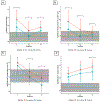High-dimensional proteomics identifies organ injury patterns associated with outcomes in human trauma
- PMID: 36787435
- PMCID: PMC10205666
- DOI: 10.1097/TA.0000000000003880
High-dimensional proteomics identifies organ injury patterns associated with outcomes in human trauma
Abstract
Introduction: Severe traumatic injury with shock can lead to direct and indirect organ injury; however, tissue-specific biomarkers are limited in clinical panels. We used proteomic and metabolomic databases to identify organ injury patterns after severe injury in humans.
Methods: Plasma samples (times 0, 24, and 72 hours after arrival to trauma center) from injured patients enrolled in two randomized prehospital trials were subjected to multiplexed proteomics (SomaLogic Inc., Boulder, CO). Patients were categorized by outcome: nonresolvers (died >72 hours or required ≥7 days of critical care), resolvers (survived to 30 days and required <7 days of critical care), and low Injury Severity Score (ISS) controls. Established tissue-specific biomarkers were identified through a literature review and cross-referenced with tissue specificity from the Human Protein Atlas. Untargeted plasma metabolomics (Metabolon Inc., Durham, NC), inflammatory mediators, and endothelial damage markers were correlated with injury biomarkers. Kruskal-Wallis/Mann-Whitney U tests with false discovery rate correction assessed differences in biomarker expression across outcome groups (significance; p < 0.1).
Results: Of 142 patients, 78 were nonresolvers (median ISS, 30), 34 were resolvers (median ISS, 22), and 30 were low ISS controls (median ISS, 1). A broad release of tissue-specific damage markers was observed at admission; this was greater in nonresolvers. By 72 hours, nine cardiac, three liver, eight neurologic, and three pulmonary proteins remained significantly elevated in nonresolvers compared with resolvers. Cardiac damage biomarkers showed the greatest elevations at 72 hours in nonresolvers and had significant positive correlations with proinflammatory mediators and endothelial damage markers. Nonresolvers had lower concentrations of fatty acid metabolites compared with resolvers, particularly acyl carnitines and cholines.
Conclusion: We identified an immediate release of tissue-specific biomarkers with sustained elevation in the liver, pulmonary, neurologic, and especially cardiac injury biomarkers in patients with complex clinical courses after severe injury. The persistent myocardial injury in nonresolvers may be due to a combination of factors including metabolic stress, inflammation, and endotheliopathy.
Copyright © 2023 Wolters Kluwer Health, Inc. All rights reserved.
Conflict of interest statement
Figures





References
-
- Rhee P, Joseph B, Pandit V, Aziz H, Vercruysse G, Kulvatunyou N, et al. Increasing trauma deaths in the United States. Ann Surg. 2014;260(1):13–21. - PubMed
-
- Alberdi F, Garcia I, Atutxa L, Zabarte M, Trauma, Neurointensive Care Work Group of the S. Epidemiology of severe trauma. Med Intensiva. 2014;38(9):580–8. - PubMed
-
- Dimopoulou I, Tsagarakis S, Theodorakopoulou M, Douka E, Zervou M, Kouyialis AT, et al. Endocrine abnormalities in critical care patients with moderate-to-severe head trauma: incidence, pattern and predisposing factors. Intensive Care Med. 2004;30(6):1051–7. - PubMed
Publication types
MeSH terms
Substances
Grants and funding
LinkOut - more resources
Full Text Sources

